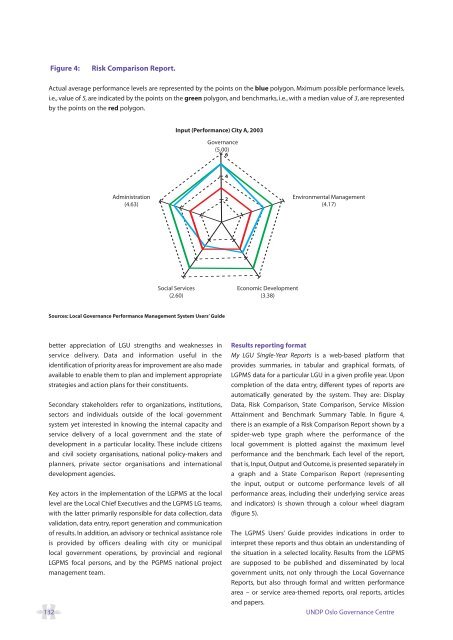A Users' Guide to Measuring Local Governance
A Users' Guide to Measuring Local Governance
A Users' Guide to Measuring Local Governance
Create successful ePaper yourself
Turn your PDF publications into a flip-book with our unique Google optimized e-Paper software.
Figure 4:<br />
Risk Comparison Report.<br />
Actual average performance levels are represented by the points on the blue polygon. Mximum possible performance levels,<br />
i.e., value of 5, are indicated by the points on the green polygon, and benchmarks, i.e., with a median value of 3, are represented<br />
by the points on the red polygon.<br />
Input (Performance) City A, 2003<br />
<strong>Governance</strong><br />
(5.00)<br />
6<br />
4<br />
Administration<br />
(4.63)<br />
2<br />
Environmental Management<br />
(4.17)<br />
Social Services<br />
(2.60)<br />
Economic Development<br />
(3.38)<br />
Sources: <strong>Local</strong> <strong>Governance</strong> Performance Management System Users’ <strong>Guide</strong><br />
better appreciation of LGU strengths and weaknesses in<br />
service delivery. Data and information useful in the<br />
identification of priority areas for improvement are also made<br />
available <strong>to</strong> enable them <strong>to</strong> plan and implement appropriate<br />
strategies and action plans for their constituents.<br />
Secondary stakeholders refer <strong>to</strong> organizations, institutions,<br />
sec<strong>to</strong>rs and individuals outside of the local government<br />
system yet interested in knowing the internal capacity and<br />
service delivery of a local government and the state of<br />
development in a particular locality. These include citizens<br />
and civil society organisations, national policy-makers and<br />
planners, private sec<strong>to</strong>r organisations and international<br />
development agencies.<br />
Key ac<strong>to</strong>rs in the implementation of the LGPMS at the local<br />
level are the <strong>Local</strong> Chief Executives and the LGPMS LG teams,<br />
with the latter primarily responsible for data collection, data<br />
validation, data entry, report generation and communication<br />
of results. In addition, an advisory or technical assistance role<br />
is provided by officers dealing with city or municipal<br />
local government operations, by provincial and regional<br />
LGPMS focal persons, and by the PGPMS national project<br />
management team.<br />
Results reporting format<br />
My LGU Single-Year Reports is a web-based platform that<br />
provides summaries, in tabular and graphical formats, of<br />
LGPMS data for a particular LGU in a given profile year. Upon<br />
completion of the data entry, different types of reports are<br />
au<strong>to</strong>matically generated by the system. They are: Display<br />
Data, Risk Comparison, State Comparison, Service Mission<br />
Attainment and Benchmark Summary Table. In figure 4,<br />
there is an example of a Risk Comparison Report shown by a<br />
spider-web type graph where the performance of the<br />
local government is plotted against the maximum level<br />
performance and the benchmark. Each level of the report,<br />
that is, Input, Output and Outcome, is presented separately in<br />
a graph and a State Comparison Report (representing<br />
the input, output or outcome performance levels of all<br />
performance areas, including their underlying service areas<br />
and indica<strong>to</strong>rs) is shown through a colour wheel diagram<br />
(figure 5).<br />
The LGPMS Users’ <strong>Guide</strong> provides indications in order <strong>to</strong><br />
interpret these reports and thus obtain an understanding of<br />
the situation in a selected locality. Results from the LGPMS<br />
are supposed <strong>to</strong> be published and disseminated by local<br />
government units, not only through the <strong>Local</strong> <strong>Governance</strong><br />
Reports, but also through formal and written performance<br />
area – or service area-themed reports, oral reports, articles<br />
and papers.<br />
132 UNDP Oslo <strong>Governance</strong> Centre








![GuÃa del Usuario ] - Governance Assessment Portal](https://img.yumpu.com/44740603/1/190x253/gua-a-del-usuario-governance-assessment-portal.jpg?quality=85)







